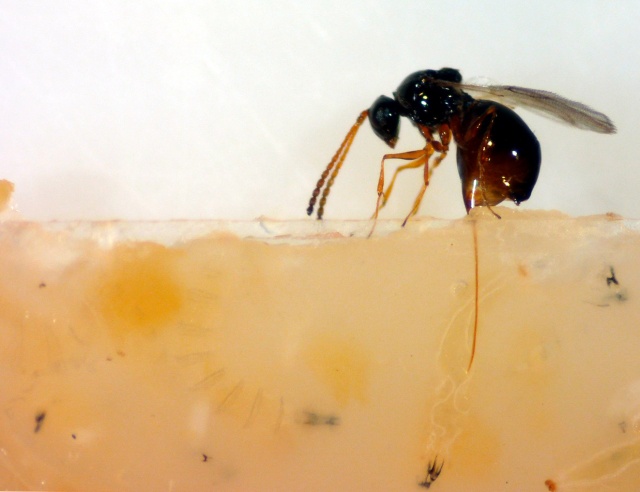It turns out that indigenous Arctic groups, and men are more tolerant of cold weather (and me… I am too).
So as you contemplate the cold weather outside and wonder: oh god, oh god why me, read about exactly why here!

It turns out that indigenous Arctic groups, and men are more tolerant of cold weather (and me… I am too).
So as you contemplate the cold weather outside and wonder: oh god, oh god why me, read about exactly why here!

I am rarely aware of what the date is. Along with struggling to remember which is “right” and “left” this is one of my most basic flaws.
So I’m almost never aware when it’s April Fool’s Day, and when I read the tweet from Richard Lenski:
I was fooled. I’ll admit it. But then I read the post, and realized, while hilarious, he was kidding.
See follow up post for confirmation. 30-years, 70,000 generations and we’re just scratching the surface.

Biologist who study experimental evolution will tell you that they get to see species evolve all the time. However, for the first time, scientists have been able to see the evolution of a completely new species, in the wild, in real-time. And it’s not something rapidly evolving like bacteria.
It’s a new species of Darwin’s finch, endemic to a small island in the Galápagos, Daphne Major. And it evolved in just two generations.
Read about this awesome study, and gather fodder for that argument that “evolution isn’t true” that you might be having over your Thanksgiving weekend, here!

Spotted hyenas are found in just about every habitat in sub-Saharan Africa including human-disturbed areas and fully urbanized ones (i.e., cities) (Yirga Abay, Bauer, Gebrihiwot, & Deckers, 2010). While most large carnivores in Africa are decreasing in number, spotted hyenas are thriving. One reason for this inconsistency may be their high degree of behavioral flexibility; they’re dietary generalists eating everything and anything from termites to elephants (Holekamp & Dloniak, 2010).
Want to know more? Read about it here.

One problem with honey bees is that we move them around so much. Specifically half of the bees in the US go to California during a critical 22 day period to pollinate the almond orchards.
This means that most bees are best adapted to survive in the California, which means that the PNW bees don’t really thrive in their colder than optimal environment.
Well one bee keeper is taking it upon himself to stop honey production and focus on making queens that are best suited for the Washington and PNW environment! Read about it here.

Octopus are not aliens, but they can be vicious. Combine that with an incredible intelligence, and we should all be worried that cephalopods populations are increasing world wide.
As coral reefs are dying, cephalopods are booming (likely not a causative correlation). And not just octopus, but also cuttlefish, and 35 other species of genera, spanning all major ocean regions.
Why are they expanding in number? It’s unclear, but read about possible reasons over at Gizmodo.
I, for one, would like to extend a welcome to our new cephalopod overlords.
Intense breeding since the 1300s has bread canaries of all colors of the rainbow. But until 1920, one color, red, remained elusive.
After crossing the canaries with the red siskin of Venezuela (and careful mating over subsequent generations, they managed to move the gene for “red” into the canaries! The canary is the first animal that was purposely genetically modified by moving genes from another species into it.
And finding the gene that caused this color shift proved equally difficult. Until now.
Read about it over at the Atlantic!
Imagine you find yourself in the midst of a large-scale epidemic, similar to the scenarios portrayed in movies like Contagion or Outbreak (or both!). The disease is extremely contagious, and the probability of becoming infected is high. Now imagine that scientists fail to discover a cure. There is no Dustin Hoffman-led team of military virologists available to develop a vaccine and save humanity, and the disease persists, with the potential to infect subsequent generations. In this harsh, disease-ridden environment, how could you ensure that your future offspring would survive?
It turns out, if you were a fruit fly, you might rely on recombination.
Disease is thought to have played a major role in shaping the reproductive strategies of animals. The Red Queen hypothesis predicts that species experiencing parasite-related selection pressures are more likely to evolve sexual reproduction, along with increased rates of outcrossing and recombination. This is because, in the ongoing evolutionary arms race between hosts and parasites, a little bit of genetic variation can make it a lot harder for the parasite to “win.”
But while strategies for increasing genetic variation may improve disease resistance, they often come at a cost. Increased recombination, in particular, can reduce fitness by breaking up locally adaptive combinations of alleles. One potential way to get around this issue is to increase recombination rates only when the risk of infection is high. However, we have yet to observe direct evidence of parasite-induced recombination in animals.
In a study recently published in Science, Singh et al. sought to investigate the capacity of fruit flies to plastically increase recombination in response to infection. To do this, the researchers infected Drosophila melanogaster females with a variety of parasites, and observed the proportion of recombinant offspring the females produced.
In order to track recombination events, researchers took advantage of the known genetic basis of two visible phenotypic traits. The ebony locus and the rough locus occupy nearby positions on the same chromosome in D. melanogaster, and recessive mutations at each of these loci have easily identifiable effects on the phenotype. For this study, the researchers generated females heterozygous at both ebony and rough.
Next, the researchers infected females with one of several different types of parasites. Two distinct (but similarly disturbing-sounding) methods were used to infect flies, depending on the type of parasite involved. In some trials, the researchers stabbed adult flies in the thorax with a needle covered in disease-causing bacteria. In other trials, the researchers housed larval flies with female parasitic wasps, allowing the wasps to inject their eggs directly into the larvae. Seriously, these flies must have been terrified.

A parasitic wasp (Leptopilina heterotoma) probes for fruit fly larvae with her ovipositor. (Photo courtesy of Dr. Michael Martin)
Finally, the researchers backcrossed infected females to double-mutant males, and examined the resulting offspring. Sorting through thousands of individual flies, researchers identified recombinant offspring as those that exhibited one mutant trait but not the other.
As predicted by the Red Queen hypothesis, infected females produced significantly more recombinant offspring than non-infected females. The researchers saw this pattern across all types of infection studied, including infection by species that parasitize D. melanogaster in the wild. Furthermore, the effect persisted across host life stages, with females producing more recombinant offspring even when infection occurred during the larval stage of development.
The study also provided some insight on the underlying mechanism for making more recombinant offspring, which – surprisingly – appears not to involve an actual increase in recombination rate. Instead, the culprit looks to be some form of transmission distortion, whereby recombinant gametes are promoted at the expense of non-recombinants.
This study highlights the remarkable ability of individual organisms to rapidly respond to changes in the environment, as well as the central role disease has played in shaping the evolutionary trajectory of animals.
But the reason I’m REALLY excited about these findings is because of their potential to reinvigorate the post-apocalyptic science fiction genre.
Picture this: 50 years after the emergence of an unprecedentedly deadly cross-species pathogen, the majority of the planet’s human population has been wiped out. The only people remaining are the highly recombinant offspring of those infected with (and ultimately killed by) the disease. In a world where survival of the fittest reigns supreme, these exceptionally disease-resistant individuals must attempt to rebuild society as they contend with resource shortages, lawless bands of savages, and the unknown genetic ramifications of the extreme levels of heterozygosity within their population.
It sounds like the beginnings of a pretty solid screenplay to me.
While you’re waiting for my movie to hit theaters, you can read the full text of the Science article here. And check out the video below (courtesy of Dr. Michael Martin), which shows a parasitic wasp female attempting to deposit her eggs in some (probably pretty freaked out) fruit fly larvae.

Birds do it, beetles do it … (Flickr: Henry Burrows)
Last spring, the journal Current Biology published a report describing something new under the entomological sun: A genus of tiny cave-dwelling insects, dubbed Neotrogla, in which females, not males, have penises.
Or, rather, the females have a thing that they stick inside the males. Once it’s in there, that thing inflates and latches into the male with tiny barbs, binding the couple together in a copulation lasting two to three days, while the thing collects a packet containing sperm and a whole lot of (potentially) nutritious protein. What to call the females’ thing seems to have puzzled even the scientists who described it. In the text of their paper, they call it a gynosome (literally, a “female body”); but in the title, it’s a “female penis.”
This synonymy went from confusing to controversial the moment it hit the popular science press, which almost uniformly chose to go penis-first. “Female insect uses spiky penis to take charge” read the headline in the prestigious journal Nature. “Meet the female insect with giant PENIS whose steamy sex sessions last 70 HOURS,” said the Daily Mirror, caps-locked emphasis sic. Most of the stories, even the Mirror’s, got around to using the word “gynosome” eventually, and many went into more detail about how the organ in question wasn’t really a penis as we know it. LiveScience noted it was “a complex organ composed of muscles, ducts, membranes and spikes,” before adding that its size, relative to the body of a Neotrogla female, was “the equivalent of a man who is 5 feet 9 inches (1.75 meters) tall having a penis about 9.8 inches (24.9 centimeters) long.”
Morphological convergence is one of the most striking patterns in evolution. Just among mammals there are spectacular and bizarre examples of distantly related species that share surprisingly similar adaptations. I bet you’ve heard of saber-toothed cats. But what about marsupial saber-toothed cats? Raccoons are surely familiar, but have you heard of raccoon dogs? Or the earless, eyeless oddity that is the golden mole, which somehow looks almost exactly like the equally earless and eyeless notoryctid marsupial mole? My favorite, though, might be the lesser hedgehog tenrec from Madagascar, which bears the same tiny coat of spiked armor as the common hedgehog but is more closely related to an elephant.
Until recently, most scientists studying evolutionary convergence have focused on the converged phenotype (external appearance), but with the arrival of ever-cheaper DNA sequencing technologies, scientists can efficiently study patterns of convergent genotypes across thousands of genes in species that appear to have converged at the phenotypic level.
Now, I know dancing sharks are the preferred marine species of the moment, but allow me to reignite your interest in some other denizens of the sea. Last month, a team of researchers published a study in Nature examining how genes in three marine mammal lineages might have converged independently on the same solution to the very hard physiological problem of living in the ocean after millions of years evolving on land (Foote et al. 2015). Their results are hardly conclusive but do illustrate a compelling new way to think about and study convergence now that genomes are getting so cheap to produce.

Katy Perry and her dancing sharks at the 2015 Super Bowl
You must be logged in to post a comment.